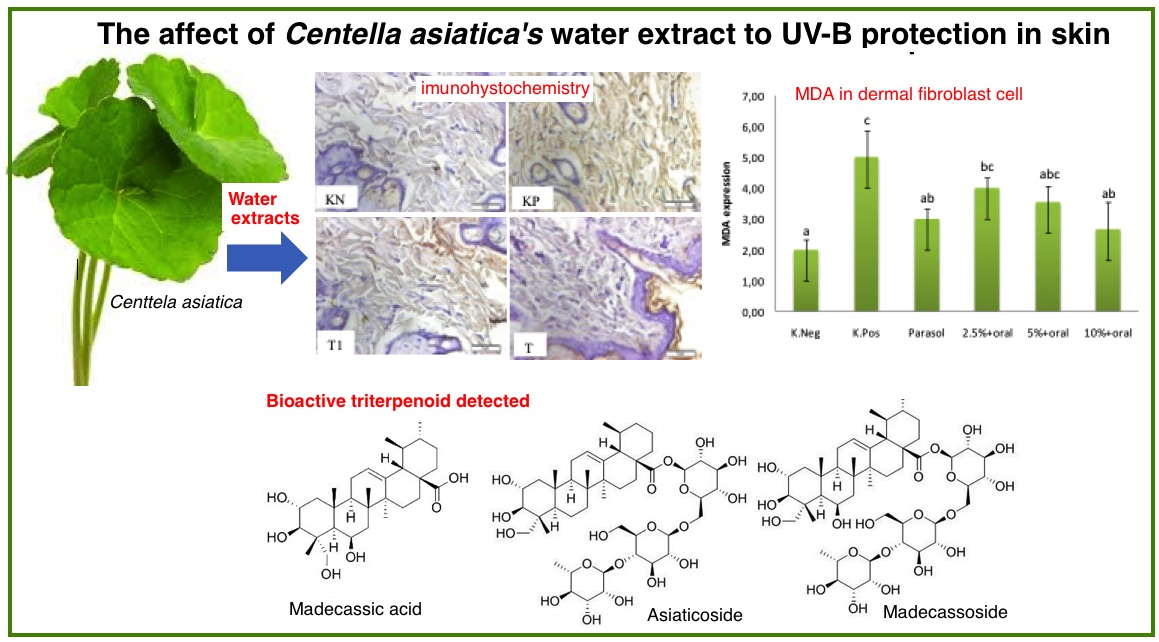Effects of Oral and Topical Application of Centella asiatica Extracts on The UVB-Induced Photoaging of Hairless Rats
Abstract

Chronic exposure to UVB irradiation can caused premature skin aging (photoaging), as it can trigger the production of ROS and initiate both oxidative stress in cell membrane and affect the molecular pathway. This paper figured out the potential of oral and topical administration of C. asiatica extract on hairless rats skin tissue exposed by UVB based on expression of TGF-β1, MMP-1 and MDA dermis. A total of 30 male-hairless rats (Rattus novergicus) divided into 6 experimental groups, exposed by UVB with total dose 840 mJ/cm2 for four weeks. Topical gel therapy administered twice a day, 20 minutes before and 4 hours after irradiation. Oral therapy administered once a day before irradiation. Expression of TGF-β1, MMP-1 and MDA dermis observed by immunohistochemistry. The result showed that oral and topical therapy of C. asiatica extract was capable of inhibiting the increase of MMP-1 and MDA expression and the decrease of TGF- β1 significantly (p<0.05) in the dermal fibroblast of Wistar rat that exposed UVB light.
References
[1] Binic, I., Lazarevic, V., Ljubenovic, M., Mojsa, J., & Sokolovic, D., eCAM, 2013, 2013, 827248.
[2] Ganceviciene, R., Liakou, A. I., Theodoridis, A., Makrantonaki, E. & Zouboulis, C. C., Dermatoendocrinol., 2012, 4 (3), 308–319.
[3] Masnec, I. S. & Poduje, S., Coll. Antropol., 2008, 32 (Suppl. 2), 177–180.
[4] Svobodova, A., Walterova, D. & Vostalova, J., Biomed Pap Med Fac Univ Palacky Olomouc Czech Repub., 2006, 150 (1), 25-38.
[5] Masaki, H., J Dermatol Sci;, 2010, 58, 85–90.
[6] Helfrich, Y. R., Sachs, D. L. & Voorhees, J. J., Dermatol Nurs., 2008, 20 (3), 177-83.
[7] Sun, Z. W., Hwang, E., Lee, H. J., Lee, T. Y., Song, H.G., Park, S. Y., Shin, H. S., Lee, D. G., Yi, T. H., J. Nat. Med., 2015, 69, 22–34.
[8] Ayala, A., Muñoz, M. F. & Argüelles. S., Oxid Med Cell Longev., 2014, 1-31.
[9] Kim, Y.H., Kim, K.S., Han, C.S., Yang, H.C., Park, S.H., Ko, K.I., Lee, S.H., Kim, K. H., Lee, N.H., Kim, J. M., Son, K. H., Int. J. Cosmet. Sci., 2007, 29, 487–488.
[10] Yasurin, P., Sriariyanun, M. & Phusantisampun, T., KMUTNB Int J Appl Sci Technol., 2016, 9(1), 1-9.
[11] Kundu, S., Haque, Sk. M. & Ghosh, B., J. Appl. Pharm.l Sci., 2015, 5 (Suppl 2), 030-036.
[12] Chen, Y., Han, T., Rui, Y., Yin, M., Qin, L. & Zheng, H., Zhong Yao Cai, 2003, 26, 870-873.
[13] Hamid, A. A., Md Shah, Z., Muse, R. & Mohamed, S., Food Chem., 2002, 77, 465-469.
[14] Anton-Nb.com. (2020). Antioksidan Kunci Agar Selalu Awet Muda Dan Hidup Sehat Lebih Lama. [online] Available at: https://www.anton-nb.com/2019/10/antioksidan-kunci-agar-selalu-awet-muda.html [Accessed 16 Jan. 2020].
[15] Hashim, P., Int. Food Res. J., 2011, 18, 1215-1222.
[16] Bylka, W., Znajdek-Awiżeń, P., Studzińska-Sroka, E. & Brzezińska, M., Postepy Dermatol Alergol., 2013, 30 (1), 46–49.
[17] Maramaldi, G., Togni, S., Franceschi, F. & Lati, E., Clin Cosmet Investig Dermatol., 2014, 7, 1–9.
[18] An, I., An, S., Kang, S., Choe, T., Lee, S. N., Jang, H. H. & Bae, S., Int J Mol Med, 2012, 30, 1194-1202.
[19] Kwon, M. C., W. Y. Choi, Y. C. Seo, J. S. Kim, C. S. Yoon, H. W. Lim, H. S. Kim, J. Ahna, H. Y. Lee, J. Biotechnol., 2011, 157 (2012), 100–106.
[20] Sujono, T. A., Hidayah, U. N. W. & Sulaiman, T. N. S., Biomedika, 2014, 6 (2), 9–17.
[21] Gajbhiye, N.A., Makasana, J., Saha, A., Patel, I., Jat, R.S., Chromatographia, 2016, 79(11–12), 727–739.
Refbacks
- There are currently no refbacks.

This work is licensed under a Creative Commons Attribution-NonCommercial 4.0 International License.








